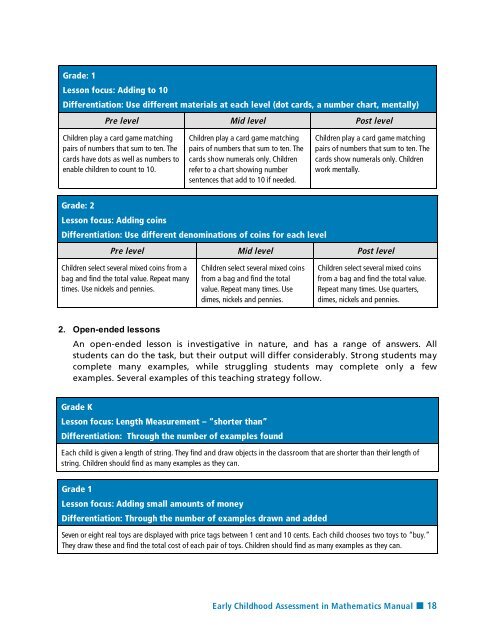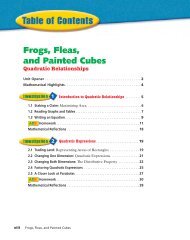ECAM-Manual-and-Resources
ECAM-Manual-and-Resources
ECAM-Manual-and-Resources
You also want an ePaper? Increase the reach of your titles
YUMPU automatically turns print PDFs into web optimized ePapers that Google loves.
Grade: 1<br />
Lesson focus: Adding to 10<br />
Differentiation: Use different materials at each level (dot cards, a number chart, mentally)<br />
Pre level Mid level Post level<br />
Children play a card game matching<br />
pairs of numbers that sum to ten. The<br />
cards have dots as well as numbers to<br />
enable children to count to 10.<br />
Children play a card game matching<br />
pairs of numbers that sum to ten. The<br />
cards show numerals only. Children<br />
refer to a chart showing number<br />
sentences that add to 10 if needed.<br />
Children play a card game matching<br />
pairs of numbers that sum to ten. The<br />
cards show numerals only. Children<br />
work mentally.<br />
Grade: 2<br />
Lesson focus: Adding coins<br />
Differentiation: Use different denominations of coins for each level<br />
Pre level Mid level Post level<br />
Children select several mixed coins from a<br />
bag <strong>and</strong> find the total value. Repeat many<br />
times. Use nickels <strong>and</strong> pennies.<br />
Children select several mixed coins<br />
from a bag <strong>and</strong> find the total<br />
value. Repeat many times. Use<br />
dimes, nickels <strong>and</strong> pennies.<br />
Children select several mixed coins<br />
from a bag <strong>and</strong> find the total value.<br />
Repeat many times. Use quarters,<br />
dimes, nickels <strong>and</strong> pennies.<br />
2. Open-ended lessons<br />
An open-ended lesson is investigative in nature, <strong>and</strong> has a range of answers. All<br />
students can do the task, but their output will differ considerably. Strong students may<br />
complete many examples, while struggling students may complete only a few<br />
examples. Several examples of this teaching strategy follow.<br />
Grade K<br />
Lesson focus: Length Measurement – “shorter than”<br />
Differentiation: Through the number of examples found<br />
Each child is given a length of string. They find <strong>and</strong> draw objects in the classroom that are shorter than their length of<br />
string. Children should find as many examples as they can.<br />
Grade 1<br />
Lesson focus: Adding small amounts of money<br />
Differentiation: Through the number of examples drawn <strong>and</strong> added<br />
Seven or eight real toys are displayed with price tags between 1 cent <strong>and</strong> 10 cents. Each child chooses two toys to “buy.”<br />
They draw these <strong>and</strong> find the total cost of each pair of toys. Children should find as many examples as they can.<br />
Early Childhood Assessment in Mathematics <strong>Manual</strong> ■ 18



